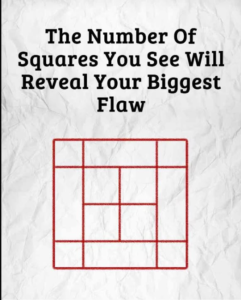The Number of Squares You See Will Reveal Your Biggest Flaw?
Exploring the Illusion, the Myth, and the Real Path to Self-Understanding
You’ve probably seen it floating around social media: a picture filled with overlapping lines and boxes, accompanied by the caption, “The number of squares you see reveals your greatest flaw.” It’s a tempting offer—one glance and you’ll uncover a deep truth about yourself. But how true is it? Is it possible that a quick visual puzzle can expose the darkest corners of your personality?
Let’s start with the illusion itself. These kinds of puzzles are a mix of optical illusion and subjective interpretation. Most of them ask you to count how many squares or shapes you see in a complex grid. Some people might count 16, others 18, and some might spot as many as 40. Each answer is often paired with a pre-written “personality flaw,” like being a perfectionist, overthinking, lacking focus, or being too trusting.
But here’s the truth: the number of squares you see likely says more about your attention to detail and visual perception than your soul’s deepest weaknesses. These puzzles are cleverly designed to engage your brain, spark debate, and keep you scrolling—not diagnose your character.
Still, there’s something deeper going on here. Why do we want a silly square-counting game to tell us our flaws? The answer lies in our natural curiosity about ourselves. Humans are wired for self-discovery. We crave insight. It’s why we’re drawn to astrology, personality quizzes, and yes—even illusions that claim to unlock secrets. There’s comfort in the idea that something outside of us can help make sense of what’s inside.
But self-understanding doesn’t come from a meme. It comes from reflection, feedback, experience, and honesty. Your biggest flaw isn’t hiding in a grid of squares—it’s hiding in your habits, your blind spots, the patterns you repeat in relationships, the way you respond to stress, or how you treat others when you’re hurting.
True self-awareness comes when you ask the uncomfortable questions:
- Why do I react this way when I feel ignored?
- What fears am I hiding behind my confidence?
- Am I listening to understand or just waiting to respond?
It’s not as fast or fun as a viral puzzle—but it’s real. That being said, illusions like the square test can still be useful. Not for diagnosing flaws, but as tools to spark conversation or introspection. “Why did I see fewer squares than others?” might lead you to think about how you process detail—or how quickly you jump to conclusions. That kind of awareness can lead somewhere meaningful.
So next time you see one of those “count the squares” images claiming to expose your inner demons, enjoy it for what it is: a brain teaser, not a therapist. Use it as a stepping stone, not a destination.
Because the real path to understanding yourself isn’t in a picture—it’s in the mirror.
